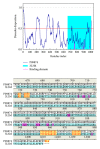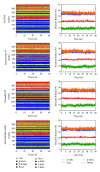In Silico Investigation of Potential PARP-1 Inhibitors from Traditional Chinese Medicine
- PMID: 24876881
- PMCID: PMC4021748
- DOI: 10.1155/2014/917605
In Silico Investigation of Potential PARP-1 Inhibitors from Traditional Chinese Medicine
Abstract
Poly(ADP-ribose) polymerases (PARPs) are nuclear enzymes which catalyze the poly-ADP-ribosylation involved in gene transcription, DNA damage repair, and cell-death signaling. As PARP-1 protein contains a DNA-binding domain, which can bind to DNA strand breaks and repair the damaged DNA over a low basal level, the inhibitors of poly(ADP-ribose) polymerase 1 (PARP-1) have been indicated as the agents treated for cancer. This study employed the compounds from TCM Database@Taiwan to identify the potential PARP-1 inhibitors from the vast repertoire of TCM compounds. The binding affinities of the potential TCM compounds were also predicted utilized several distinct scoring functions. Molecular dynamics simulations were performed to optimize the result of docking simulation and analyze the stability of interactions between protein and ligand. The top TCM candidates, isopraeroside IV, picrasidine M, and aurantiamide acetate, had higher potent binding affinities than control, A927929. They have stable H-bonds with residues Gly202 and, Ser243 as A927929 and stable H-bonds with residues Asp105, Tyr228, and His248 in the other side of the binding domain, which may strengthen and stabilize ligand inside the binding domain of PARP-1 protein. Hence, we propose isopraeroside IV and aurantiamide acetate as potential lead compounds for further study in drug development process with the PARP-1 protein.
Figures









Similar articles
-
In silico investigation of potential mTOR inhibitors from traditional Chinese medicine for treatment of Leigh syndrome.Biomed Res Int. 2014;2014:139492. doi: 10.1155/2014/139492. Epub 2014 Jun 23. Biomed Res Int. 2014. PMID: 25045657 Free PMC article.
-
Poly(ADP-ribose) polymerase-1 activation during DNA damage and repair.Methods Enzymol. 2006;409:493-510. doi: 10.1016/S0076-6879(05)09029-4. Methods Enzymol. 2006. PMID: 16793420
-
Natural inhibitors of poly(ADP-ribose) polymerase-1.Mol Neurobiol. 2012 Aug;46(1):55-63. doi: 10.1007/s12035-012-8257-x. Epub 2012 Apr 4. Mol Neurobiol. 2012. PMID: 22476980 Review.
-
Poly(ADP-ribose) polymerase-1 (PARP-1) inhibitors in cancer chemotherapy.Recent Pat Anticancer Drug Discov. 2006 Jan;1(1):39-53. doi: 10.2174/157489206775246430. Recent Pat Anticancer Drug Discov. 2006. PMID: 18221025 Review.
-
PARP Power: A Structural Perspective on PARP1, PARP2, and PARP3 in DNA Damage Repair and Nucleosome Remodelling.Int J Mol Sci. 2021 May 12;22(10):5112. doi: 10.3390/ijms22105112. Int J Mol Sci. 2021. PMID: 34066057 Free PMC article. Review.
Cited by
-
Identification of PARP12 Inhibitors By Virtual Screening and Molecular Dynamics Simulations.Front Pharmacol. 2022 Aug 9;13:847499. doi: 10.3389/fphar.2022.847499. eCollection 2022. Front Pharmacol. 2022. PMID: 36016564 Free PMC article.
-
FGFR2 regulation by picrasidine Q inhibits the cell growth and induces apoptosis in esophageal squamous cell carcinoma.J Cell Biochem. 2018 Feb;119(2):2231-2239. doi: 10.1002/jcb.26385. Epub 2017 Oct 27. J Cell Biochem. 2018. PMID: 28857247 Free PMC article.
-
Deciphering the functional mechanism of zinc ions of PARP1 binding with single strand breaks and double strand breaks.RSC Adv. 2022 Jun 29;12(30):19029-19039. doi: 10.1039/d2ra02683j. eCollection 2022 Jun 29. RSC Adv. 2022. PMID: 35865614 Free PMC article.
-
Cassaine Diterpenoid Amide from Stem Bark of Erythrophleum fordii Suppresses Cytotoxic and Induces Apoptosis of Human Leukemia Cells.Molecules. 2020 Jul 21;25(14):3304. doi: 10.3390/molecules25143304. Molecules. 2020. PMID: 32708204 Free PMC article.
References
-
- Bai P, Canto C. The role of PARP-1 and PARP-2 enzymes in metabolic regulation and disease. Cell Metabolism. 2012;16(3):290–295. - PubMed
-
- Hassa PO, Hottiger MO. The diverse biological roles of mammalian PARPs, a small but powerful family of poly-ADP-ribose polymerases. Frontiers in Bioscience. 2008;13(8):3046–3082. - PubMed
LinkOut - more resources
Full Text Sources
Other Literature Sources
Research Materials
Miscellaneous

